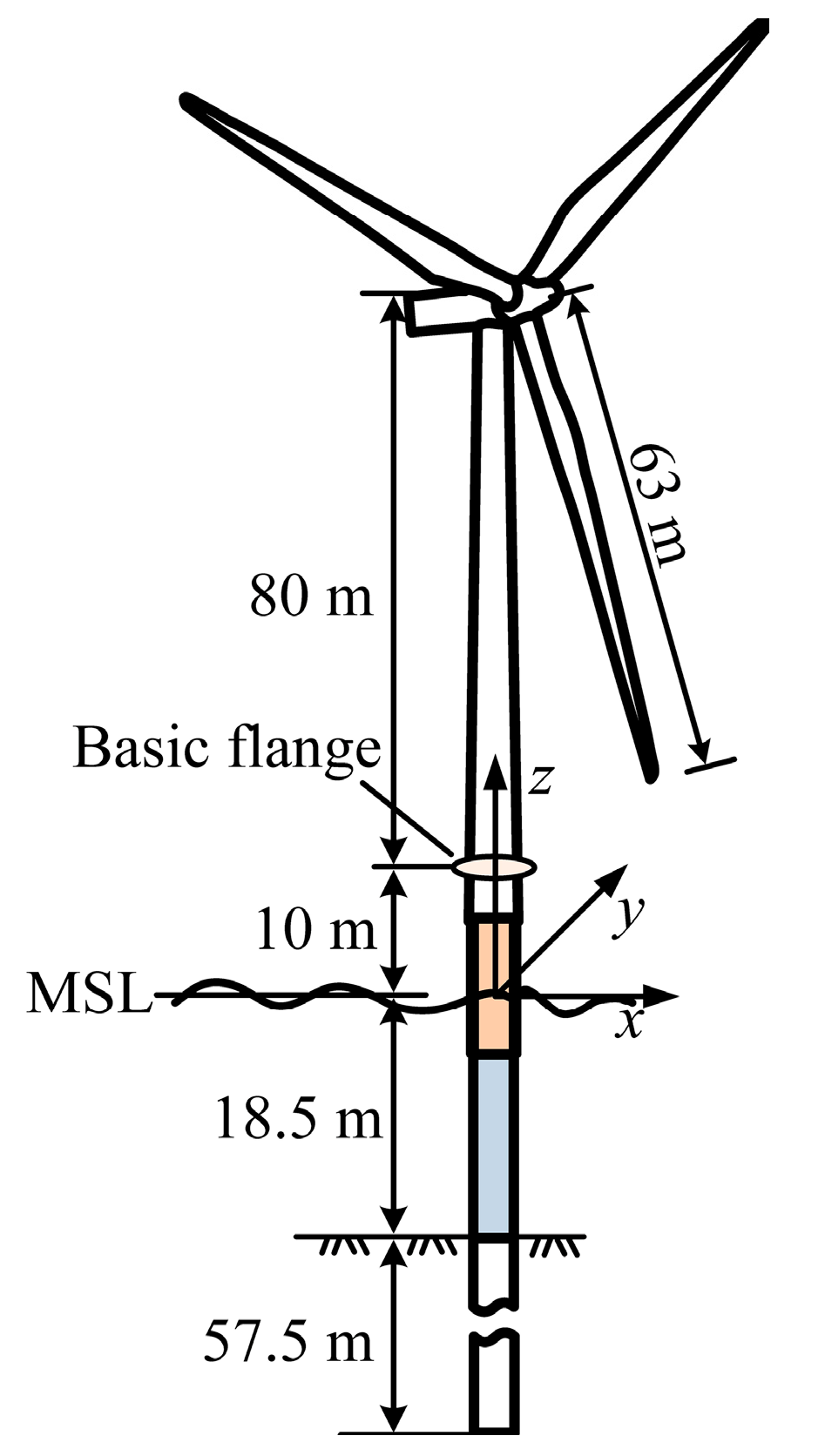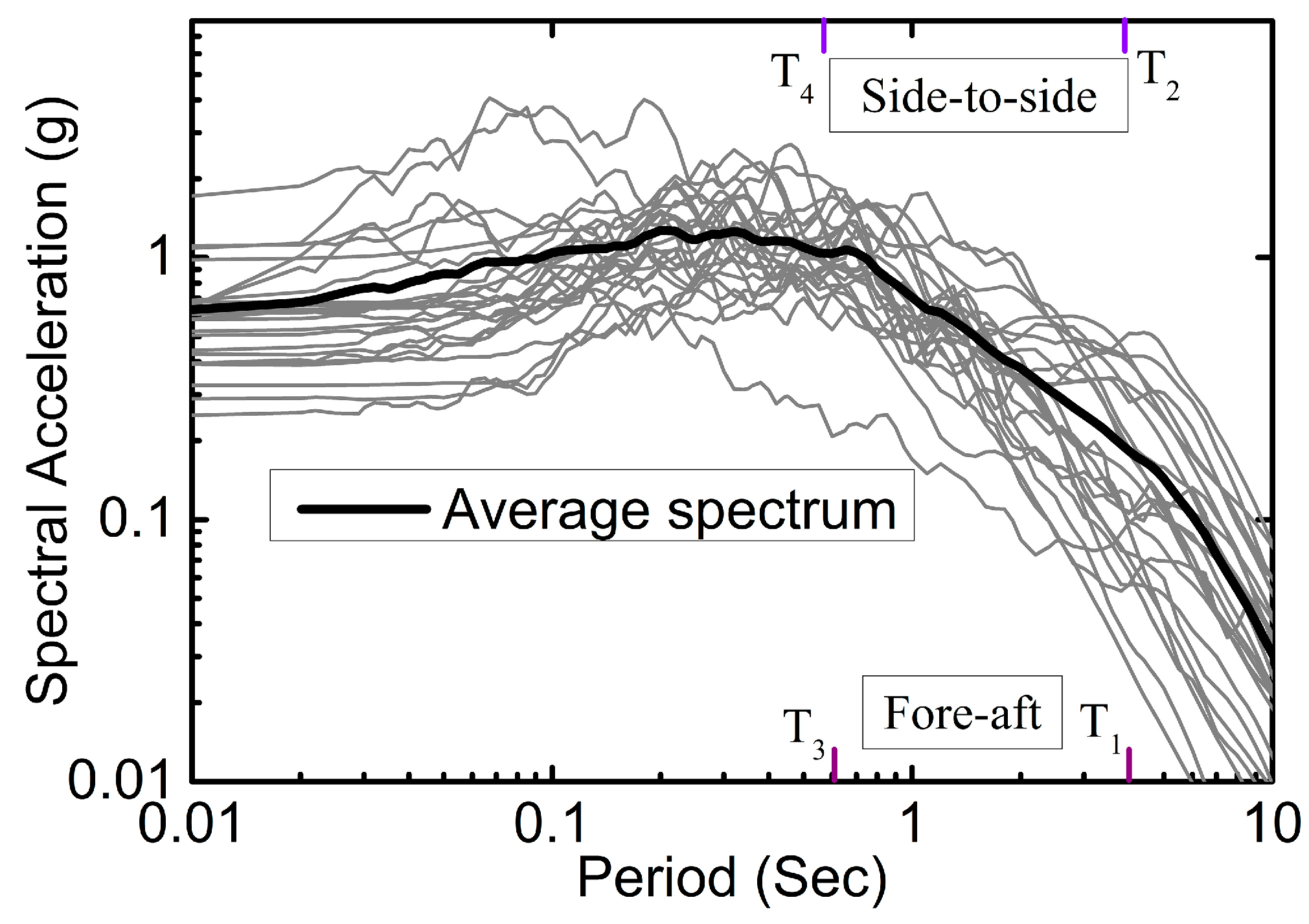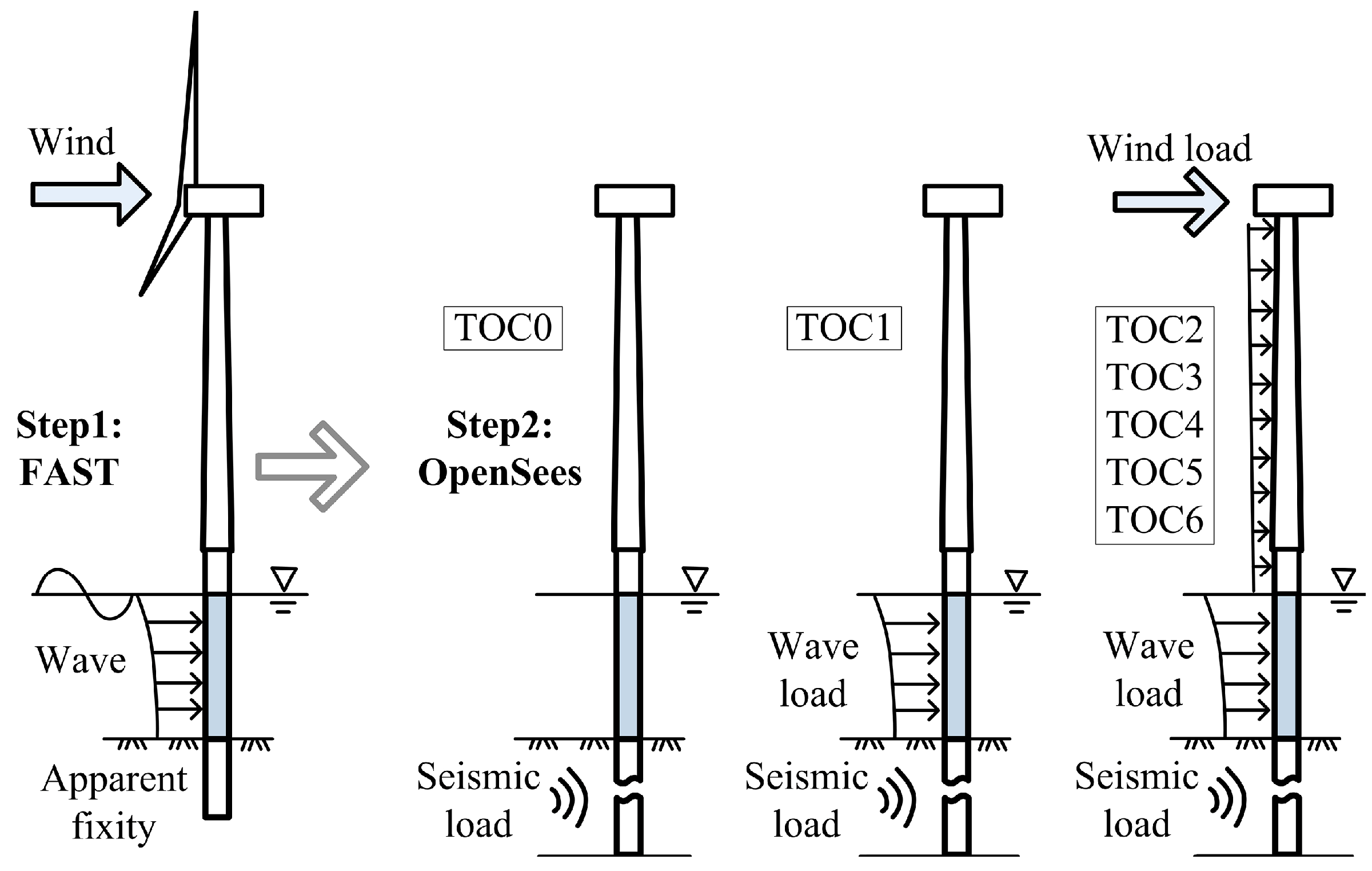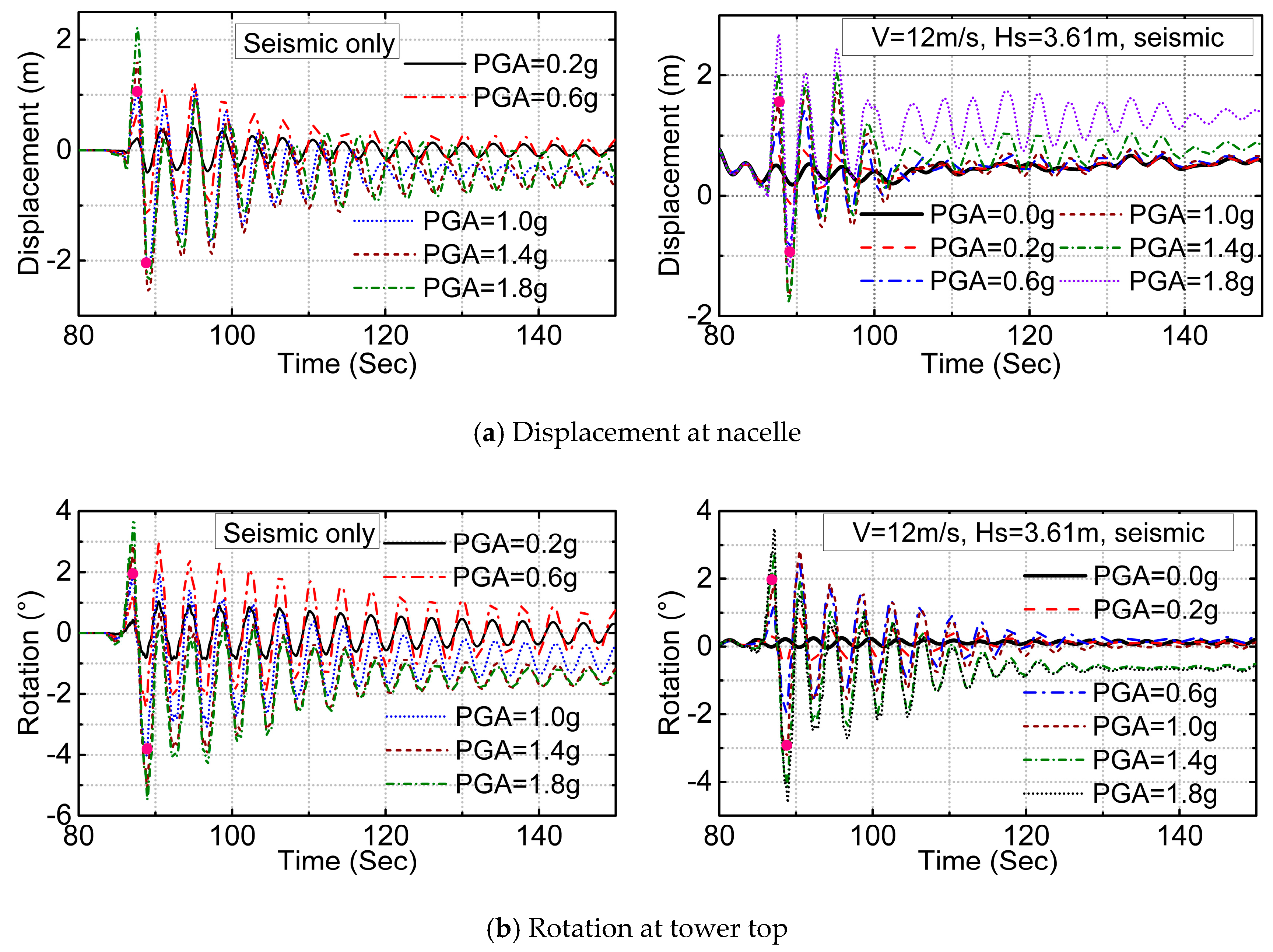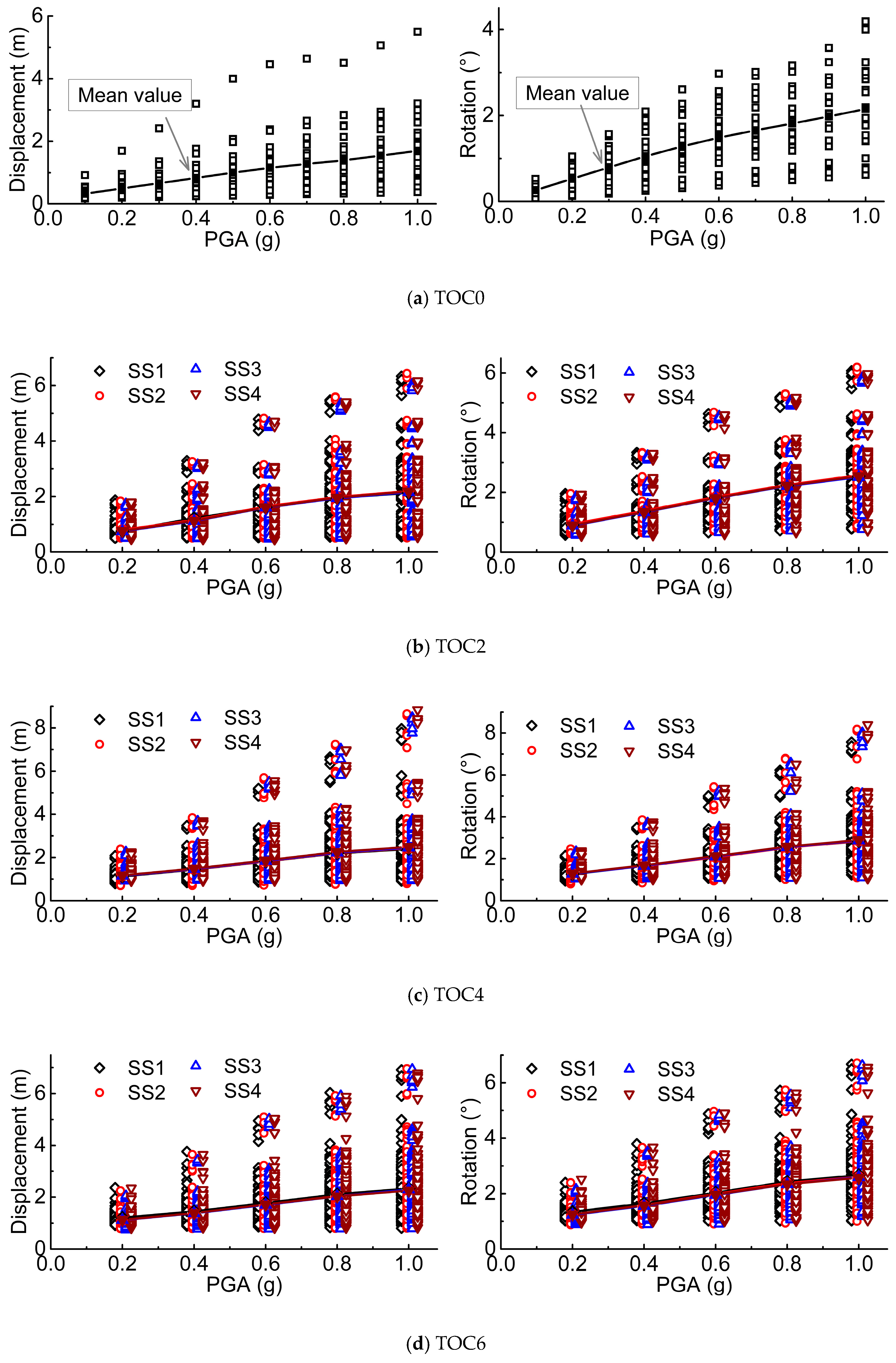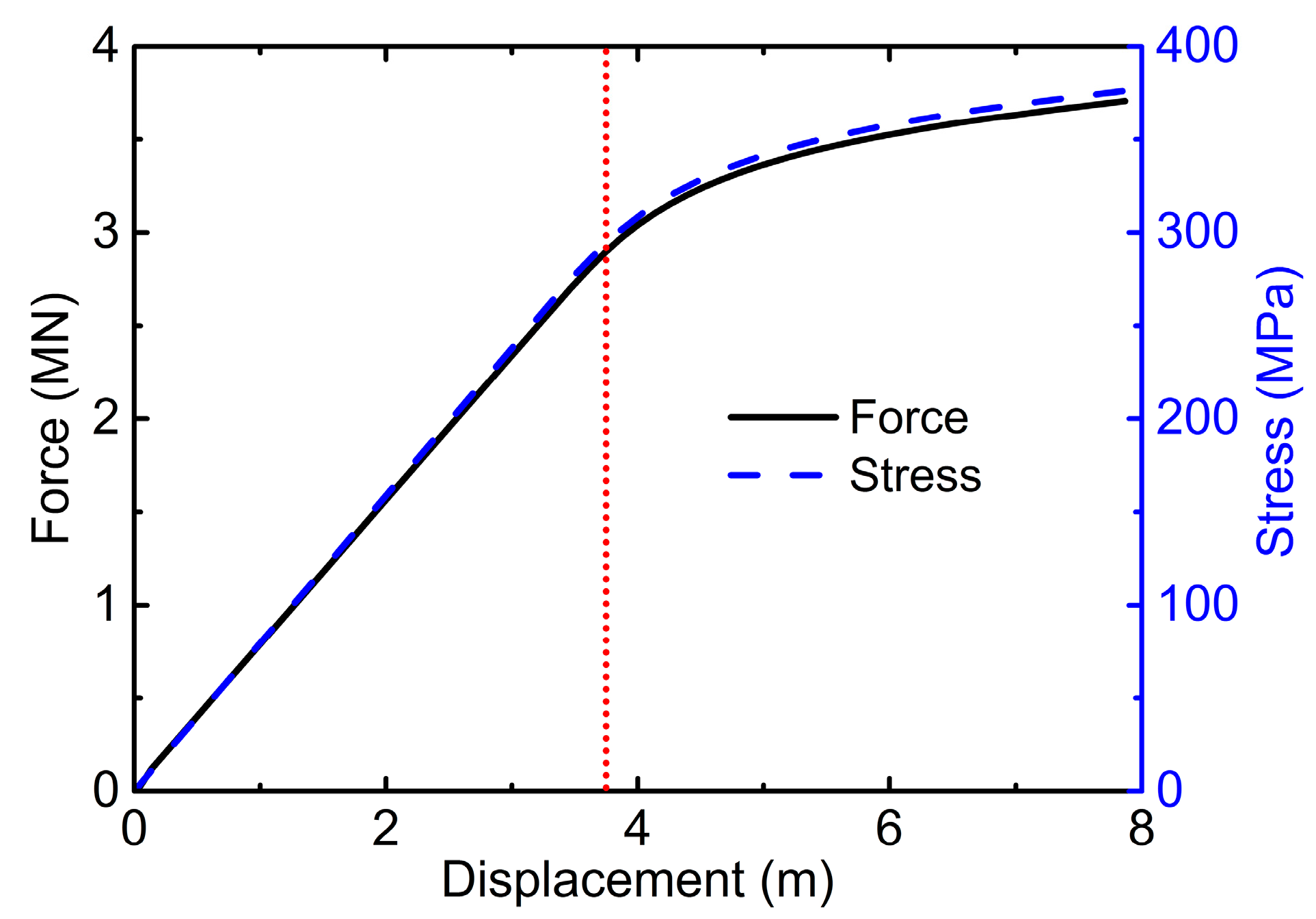1. Introduction
The depletion of fossil fuel reserves, deterioration of the global environment, and the ever-increasing demand for energy force people to utilize renewable energy. As targeted renewable energy, offshore wind energy is attractive for its advantages of large reserves, no land occupation, and little influence on human beings [
1]. However, the harsh offshore environment conditions, including loads and poor ground condition, raise the risk of failure of offshore wind turbines, and challenge the design of wind turbine supporting structures. Normally, wind and wave loads are the two most important environmental loads acting on offshore wind turbine supporting structures. It is well understood that earthquake motions in the continental shelf from the coastal land to offshore undersea do great harm to the safety of offshore wind turbines in areas of active seismicity [
2,
3]. Since earthquakes are unpredictable, offshore wind turbines can be operating under different operation conditions when an earthquake occurs [
4,
5], resulting in different combinations of seismic load and environmental wind and wave loads acting on the wind turbine supporting structures. These combinations of loads cause different nonlinear dynamic responses for offshore wind turbines, which may exceed limit states of the structure and cause failure in both the power generation system and the supporting foundations. Thus, investigations should be conducted to understand the responses of offshore wind turbines under seismic loads or the combination of seismic loads and environmental wind and wave loads, and to evaluate the fragility of wind turbine structures.
Many attempts to study the seismic dynamic responses [
6,
7,
8,
9], structural safety [
4,
5,
10,
11,
12] and analytical methods [
4,
13] of wind turbines have been conducted. Most studies focused on onshore wind turbines, which are shorter in the cantilever length than their offshore counterparts. In addition, onshore wind turbines are grounded in relatively hard foundations while not subjected to water waves. Hong [
6] studied the responses of wind turbine blades to seismic and turbulent wind excitations, and found that the effect of turbulence on moment responses of the blade was greater than that of an earthquake when the wind turbine generator had a constant revolutions per minute. However, the dynamic responses of the wind turbine supporting structures were not accounted in the study. Bazeos et al. [
14] studied the static and seismic responses of a 450 kW wind turbine resting on a concrete square footing in a semi-rock soil using NASTRAN [
15]. Results showed that a simplified multi-degree of freedom oscillator with concentrated mass model produced accurate results for seismic responses of the wind turbine. While focusing on the modelling of the wind turbine structure, the effect of wind loads on the seismic responses of the wind turbine was not considered in the study. Lavassas et al. [
7] investigated the responses of a 1 MW wind turbine on a concrete circular footing in a rocky soil under combined wind and earthquake loadings and found that seismic loads became critical when the wind turbine tower was constructed in seismically hazardous areas and with the ground being a medium or soft soil. Stamatopolous [
16] studied the responses of a 53.95 m high wind turbine resting on a circular footing subjected to near-fault excitation. Time-domain analyses and response-spectrum based analyses showed that shear and bending-moment demand at the tower base were significantly underestimated by the Greek Design Code when near fault ground motions were considered. However, the analysis did not take into account aerodynamic loads. Based on seismic performance analysis, Prowell [
8] concluded that the consideration of aerodynamics and operational state became increasingly important as the size of the wind turbine increase. Prowell’s study also showed that soil-structure interaction was important, especially for large wind turbines. Witcher [
17] studied the responses of a 2 MW wind turbine under load cases of parked, operational, and earthquake-induced emergency shutdown. Results showed that the situation of earthquakes combined with wind turbine in operational at rated wind speeds is the driving case. Díaz and Suárez [
18] proposed an finite element model accounting for the flexibility of the blades in flapping direction and the flexibility of the tower in bending and twisting for seismic responses of operating wind turbines. By using the proposed model, they investigated the seismic responses of a 1.65 MW wind turbine with operational wind loads subjected to four ground motions. Results showed that the stress at the tower top section may exceed those from extreme winds. However, the soil-structure interaction was not considered in the model. Sapountzakis et al. [
19] studied the dynamic responses of a 5 MW wind turbine on either a surface or monopile foundation system, and found that modelling of soil-structure interaction was of great importance in the analysis of seismic response of wind turbines. Asareh et al. [
20,
21,
22] studied the seismic responses and fragility of a 5 MW wind turbine under different operational conditions. Results showed that the fragility of the wind turbine increased slightly as the wind intensity became close to the rated wind speed of the wind turbine. However, the pile-soil interaction was not considered in the study. Santangelo et al. [
23] studied the implementation of uncoupled analysis for wind and seismic loads for a 5 MW wind turbines. Kjørlaug and Kaynia [
24] conducted analyses of megawatt-sized wind turbine subjected to the vertical earthquake using SAP200 software. This study concluded that vertical ground motions have significant bearing on the design of the tower and its connection to the nacelle and performance of the turbine after the earthquake. Ma [
25] studied the dynamic response of wind turbines subject to vertical and horizontal earthquakes. The investigation concluded that it was vital to consider earthquake loads for moment demand and vertical load in the tower of the 1.65 and 3.0 MW reference turbines in seismically active regions.
As more wind farms are constructed in offshore seismically active regions, seismic assessment of offshore wind turbines has become the attention of many studies. Kim et al. [
26] performed seismic fragility analysis of a 5 MW offshore wind turbine considering soil-pile interaction. Yu et al. [
27] conducted a group of earthquake centrifuge tests to investigate the seismic performance of offshore wind turbines of different types of foundations and found that a tripod foundation offered a better solution for mitigating lateral rotation than a monopile foundation. However, in these two studies, the environmental wave and aerodynamic loads were not considered. Kourkoulis et al. [
28] investigated the seismic responses of suction caisson foundations for offshore wind turbines using non-linear three-dimensional finite element method, but static wind and wave forces were applied instead of time history loads. Through underwater shaking table tests, Zheng et al. [
29] showed that combined earthquake and wave actions were critical for the dynamic responses of a monopile 5 MW offshore wind turbine. However, the soil-structure interaction and wind loads were not considered in this study. Anastasopoulos and Theofilou [
30] studied the performance of a hybrid foundation for offshore wind turbines under environmental loads and seismic loading. Results showed that the addition of the footing to the monopile led to a pronounced increase in the moment capacity.
As reviewed, previous studies of seismic safety of wind turbines mainly focus on onshore turbines, which, as noted previously, are to a large extent, different from offshore wind turbines. On the other hand, recent research on the seismic safety of offshore wind turbines is still ongoing. Further research is needed to better understand the seismic responses of offshore wind turbines in different operational and environmental conditions, and assess the safety of the wind turbine structures. The purpose of this study was to investigate the influence of environmental loads on the seismic responses and the fragility of offshore wind turbines. The studied case was a 5 MW monopile offshore wind turbine to be installed in a wind farm in the East China Sea. The dynamic responses of the wind turbine assemble were analyzed under the scope of the finite element method using the OpenSees platform [
31]. The pile-seabed soil interaction was modeled as beam on nonlinear Winkle Foundation using the
p-y spring method. The finite element model was calibrated and verified using published results in terms of the modal modes and natural frequencies of the turbine structure. A suite of 24 earthquake ground motions were selected and scaled for simulation in the finite element model. Different sea states and turbine operating wind speeds were considered and applied as wave force and aerodynamic loads on the pile foundation, the nacelle and the tower of the model in each time step. Based on the obtained structural dynamic responses, fragility analysis was performed using different earthquake motion intensity measures (
IM), engineering demand parameters and damage states (DSs) to obtain the vulnerability of the wind turbine.
The remainder of this paper is organized as follows: the analytical fragility methodology is introduced in
Section 2; the nonlinear finite element model of the monopile offshore wind turbine is developed and calibrated in
Section 3; the seismic dynamic analyses of the wind turbine are performed in
Section 4; In
Section 5, the fragility curves of the wind turbine are obtained; Finally, conclusions are made in
Section 6.
2. Analytical Seismic Fragility Methodology
Seismic fragility is defined as the conditional probability that the seismic demand on a structure meets or exceeds its capacity for a given level of ground motion intensity [
32,
33,
34]. It indicates the vulnerability of a structure to earthquakes. Some methods of fragility analysis have been discussed in literature [
34,
35,
36]. Rather than proposing a new fragility analysis method, this paper focuses on the vulnerability of the offshore wind turbine. The truncated incremental dynamic analysis (TIDA) method [
37], which performs incremental dynamic analysis up to a preset max ground motion intensity level,
IMmax, is used for fitting the fragility functions. A brief description of the TIDA method is as follows:
Assuming that both the demand and the capacity of an offshore wind turbine follow a lognormal distribution [
32], the fragility of the wind turbine structure can be mathematically expressed as:
where
Pf(
a) is the probability that an earthquake ground motion with an intensity of
IM =
a will exceed a damage state; a value closes to 0 indicates that there is almost no exceeding probability, while a value closes to 1.0 corresponding to high risks of exceeding;
D is the seismic demand;
D0 denotes the capacity; Ф(·) is the normal cumulative distribution function;
θ and
β are the median and log standard deviation of ground motion intensity
a, respectively.
Considering an incremental dynamic analysis of
n ground motions, if there are
m ground motions that cause structure damage at
IM levels lower than
IMmax, and
n-m ground motions that do not cause structure damage prior to the analysis being stopped, the likelihood of the entire data set being observed can be expressed by assuming that the
IMi value for each ground motion is independent as:
where
φ(·) is the normal distribution probability density function; П is the product over
i values form 1 to
m. The estimators of two fragility parameters
θ and
β are obtained by maximizing the likelihood function as:
Thus, the procedure of calculating the fragility curves for a set of performance levels of an offshore wind turbine is summarized as:
- (1)
Finite element model development and calibration.
- (2)
Selecting a suite of ground motion records.
- (3)
Conducting truncated incremental dynamic simulation to obtain demands of the structure.
- (4)
Defining DSs and solve Equation (3) for the likelihood realization of and .
- (5)
Finally, calculating fragility curves for different DSs using Equation (1).
